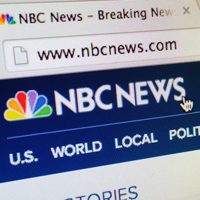Score one for those [Digiday] who [Nieman Lab] bemoan [Poynter] the rampant mobile-fication of news site designs on desktop.
NBC News has redesigned the image-heavy homepage layout that drew more than 100 angry comments to Poynter in February — and more than 300 supporters to a Change.org petition to “Reinstate a content-rich, word-navigated NBCnews.com site design.”
According to audience surveys and data obtained through the use of a test site, preview.nbcnews.com, NBC News determined what its desktop readership wanted: “The audience was looking for a faster homepage, for more scannable headlines, and for greater density,” said Gregory Gittrich, executive editor of NBCNews.com.
(That meshes with the barrage of complaints I received after writing about the February redesign. One opined, “I guess reading text is second-rate these days. Big pictures, big boxes… let the fifth-graders revel in it.”
RELATED: Time.com website redesign: ‘There’s a lot of text, and that’s intentional’
So the new homepage, rolled out this week to all readers, looks a little more like the pre-February site now (not every story has to have a huge image anymore!). But it still emphasizes large visuals for some stories and gives a prominent role to video, one of the news organization’s top priorities. (Also: rest in peace, humongous hamburger menu button.)
“While the audience that comes into the site via the desktop homepage is a minority of our users, we wanted to improve the experience for them,” Gittrich told me. “The days of people going to singular destinations are going away, so we’re investing in reaching an audience in places where people are naturally going. But we also want to do right by the audience coming directly to the homepage through desktop.”
That’s a recognition that homepage visitors still exist, especially for big, long-trusted news brands. Between 30 and 35 percent of NBC News visitors still arrive through the desktop homepage. They might be among the 2.3 million people who still subscribe to dial-up service from AOL, or they might be an older demographic than those who are on Twitter or WhatsApp all day, but they exist — in substantial numbers. And direct visitors are more engaged and spend more time on sites than social visitors do.
Gittrich has no doubts about the imperative to be mobile-first. But that doesn’t mean NBC News — and other news organizations rightfully and finally enamored with mobile — can’t also spend some time ensuring the desktop experience is as good as it can be, too. That’s why NBC News is iterating to maximize engagement on all platforms.
The public test site allows for a “continuous testing environment” for all kinds of A/B testing, Gittrich said. NBC News can roll out features to small segments of readers at a time, and can also appeal directly to readers to play around with new features on the preview site.
“Some of the things we try are going to be relatively small, like changing the color of the play button,” he said (they decided on black on yellow for video buttons).”Some of the things we try are going to be relatively big, like testing new video players.”
“We really wanted to systematically get data and feedback not only around the desktop homepage but around the whole experience,” Gittrich added, emphasizing that desktop needs are different from mobile needs. “The thinking and the goal is we will continue to iterate and optimize based on audience feedback and audience data.”
Since January, the site’s bounce rate has declined 13 percentage points, which can likely be attributed to the site’s continuous scroll feature.
RELATED: Time.com’s bounce rate down 15 percentage points since adopting continuous scroll
Video views per visit have increased 249 percent since January, and page views per visit are up 81 percent, he said, per internal Omniture data.
(This article was originally posted on Poynter’s Tumblr on Friday, Aug. 8, due to a server migration.)








Comments